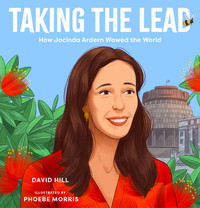Fascinating facts aren’t just found in Frank Worsley’s famous expedition to Antarctica, but also in our local shores, with captivating creatures and interesting snippets about our current Prime Minister. Writer Raymond Huber reviews two exciting new non-fiction books from publisher New Holland and Sapling’s Sarah Forster reviews the latest biography by David Hill and Phoebe Morris.
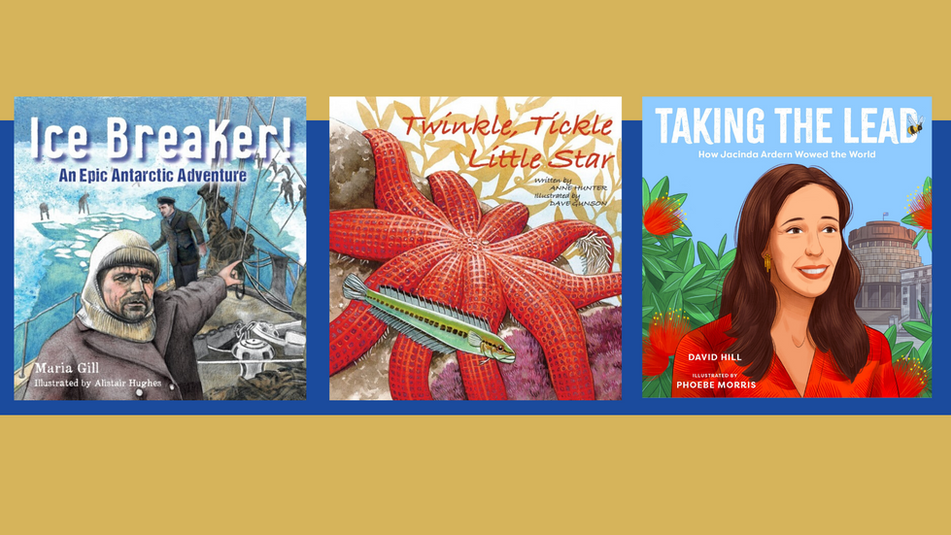
Ice Breaker! An Epic Antarctic Adventure, by Maria Gill, Illustrated by Alastair Hughes (New Holland Publishers)
Ice Breaker tells the gripping story of one of the world’s most remarkable survival voyages. When Sir Ernest Shackleton’s 1914 Trans-Antarctic expedition became trapped by ice floes, some of the crew had to make an almost impossible journey to get help. They travelled first across the ice on foot, then across 1287 km of stormy ocean, and finally over the mountains of South Georgia. As if that wasn’t enough, they then returned to rescue the twenty-two castaways left back in Antarctica.
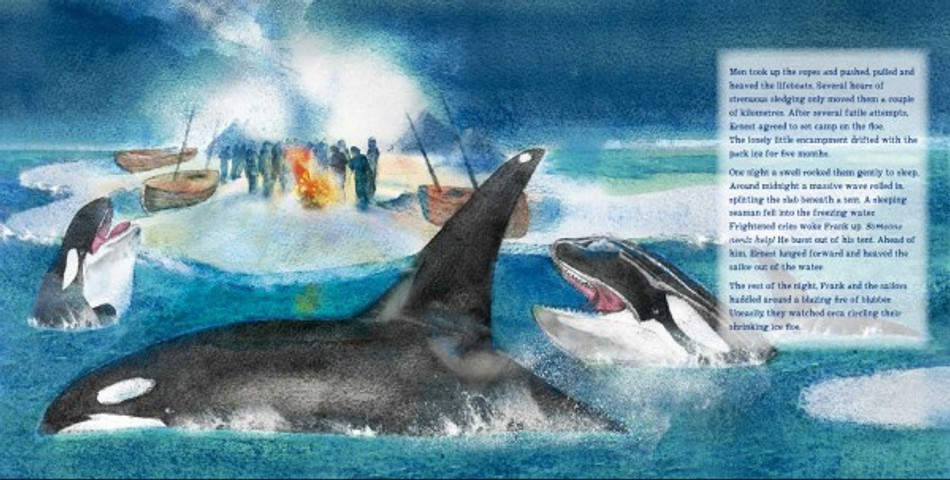
The story has been told before but in this version Maria Gill puts the focus more on the New Zealander Frank Worsley (the ‘boy from Akaroa’) than on the better known Shackleton. Worsley was the captain of the ship Endurance, and after it was crushed he guided the rescue party. He became known as ‘Captain Courageous’, and his was an inspiring feat of navigation and grit which deserves this centre stage treatment.
Worsley was the captain of the ship Endurance, and after it was crushed he guided the rescue party. He became known as ‘Captain Courageous’, and his was an inspiring feat of navigation and grit which deserves this centre stage treatment.
Maria Gill is one of the leaders in the current blossoming of creative non-fiction for children in New Zealand – she was the winner of the Storylines Margaret Mahy Medal for 2020 – and her skills are on show here. She quickly gets the reader into Worsley’s viewpoint, beginning with his dream of icebergs in London streets and then cutting efficiently to the adventure on page two. I particularly like the way she often inserts Worsley’s inner thoughts (in italics): for example, ‘I can’t miss the destination. Everyone depends on me getting it right’. This has the effect of engaging us with Worsley’s struggles, and it also works well in making him our ‘anchor’ in what is an extremely eventful narrative. There are multiple characters, boats, and locations, and it all takes place over two years. Only once did I feel confused: when they were escaping ice floes in and out of Elephant Island. The clearly annotated map at both ends of the book is a helpful, much-needed reference.
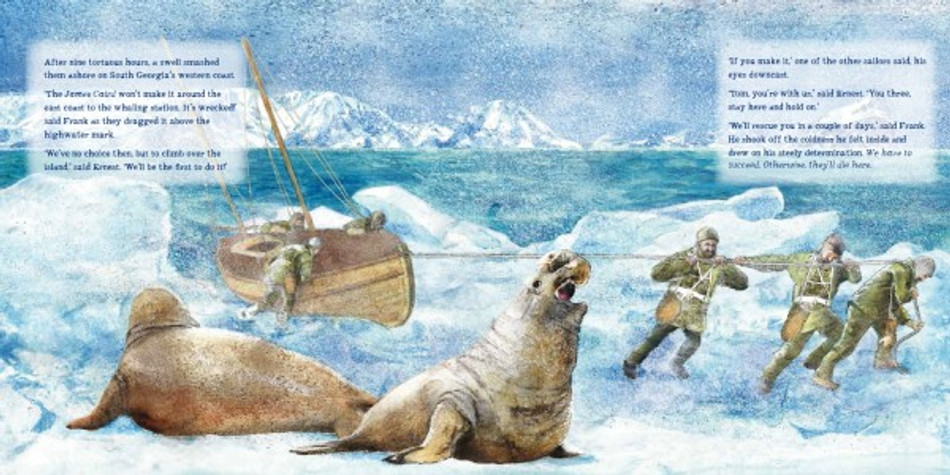
I particularly like the way she often inserts Worsley’s inner thoughts (in italics): for example, ‘I can’t miss the destination. Everyone depends on me getting it right’. This has the effect of engaging us with Worsley’s struggles, and it also works well in making him our ‘anchor’ in what is an extremely eventful narrative. There are multiple characters, boats, and locations, and it all takes place over two years. Only once did I feel confused: when they were escaping ice floes in and out of Elephant Island. The clearly annotated map at both ends of the book is a helpful, much-needed reference.
The clearly annotated map at both ends of the book is a helpful, much-needed reference.
At times events have had to be compressed for the sake of space (I presume). For example, there’s a lot of action during the incredible trip across South Georgia, where we read briefly that ‘they climbed more mountains, sidestepped crevices, and trod carefully back off a frozen lake’. I’m sure these hints will encourage readers to go on and explore this amazing story in other books (William Grill’s picture book, Shackleton’s Journey, would be a good first follow-up). Gill was inspired by Worsley’s own account in his book Shackleton’s Boat Journey, and there are other books listed in the bibliography in the back of this book.
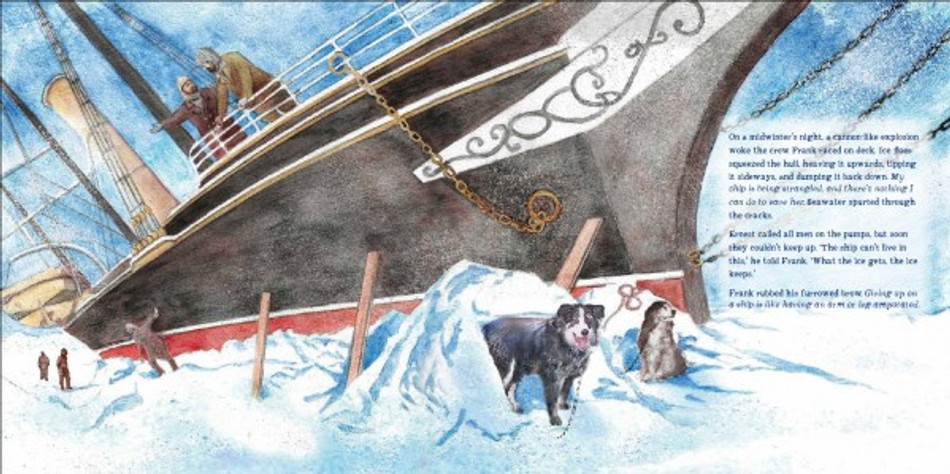
Alistair Hughes’ watercolour illustrations are rich and suitably detailed. He also wisely puts the focus of the book on the human dimension, which I think will engage primary school-aged readers more than expanses of ice and ocean. There’s an icy-blue tone to the backgrounds throughout which provides the chill factor. I also loved the rough-edged textures of the humans which both reflects their weariness and reveals their gritty determination. Hughes recreates some dramatic scenes – including the massive freak wave which swept over their tiny boat – although the cover image does not suggest how exciting the story inside is.
He also wisely puts the focus of the book on the human dimension, which I think will engage primary school-aged readers more than expanses of ice and ocean.
The book has a useful biographical appendix and a few photos from the actual expedition. New Holland Publishers have done a polished production job to create a handsome hardback book for ages seven to ten years.
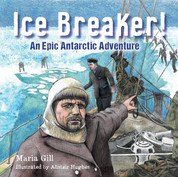
Twinkle, Tickle Little Star by Anne Hunter, illustrated by Dave Gunson (New Holland Publishers)
This colourful junior picture book is a follow-up to the wonderful Eekily, Sneakily by the same author and illustrator. Twinkle, Tickle Little Star introduces the plants, shellfish, birds and many strange creatures which children might commonly encounter on the New Zealand seashore. Readers will discover that sponges are really animals, that pāua have teeth on their tongues, and that anemones reproduce by splitting themselves in half.
Readers will discover that sponges are really animals, that pāua have teeth on their tongues, and that anemones reproduce by splitting themselves in half.
Anne Hunter’s rhyming text helps to bring the coastal habitat to life with its sense of flow and energy. She uses word-play to good effect especially with her tongue-twistery beginnings: ‘Hungrily, spongily’; ‘Snappily, clackily’; and my favourite, ‘Many anemones’. It’s hard enough to write consistent rhyming text for adults to read aloud, but Hunter also has the added constraint of making accurate facts fit into the rhymes. Sometimes this makes the rhythm falter a little; with the anemones, for example, ‘Pretty flowers, not! We’re animals,’. It flows best when the verse is tight, and is focussed on one aspect; with the pāua, for example: ‘Shimmering, glimmering/Inside it’s greeny blue;/but the outside of my shell/is a dull and dreary hue.’ Overall there is a real sense of fun to the text that children will enjoy.
It’s hard enough to write consistent rhyming text for adults to read aloud, but Hunter also has the added constraint of making accurate facts fit into the rhymes.
Dave Gunson has had over 80 books published and his expertise as an illustrator and designer is evident here. The creatures and plants here are big and bold as befits the junior age-group, many of them seeming to project out of the page: witness the close-up of a lovely katipō spider! At times the creatures become almost like characters to match the verse – my favourite is the black-backed gull which looks like it’s ready to ‘pick a fight’ with the reader. The colour here is more muted than in Eekily, Sneakily, perhaps because of the more water-based settings. There’s just the right amount of natural detail to the plants and animals, as well as a clear sense of the surrounding habitat.
At times the creatures become almost like characters to match the verse – my favourite is the black-backed gull which looks like it’s ready to ‘pick a fight’ with the reader.
Older readers will also like the ‘Fascinating Facts’ section at the back of the book which goes into a bit more scientific detail. For example, it explains how shellfish use ‘jet propulsion’ to get around; why hermit crabs need to live in shells, and the rather graphic eating habits of the seastar: ‘it pushes its stomach out through its mouth’!
It’s great to see more of this kind of creative non-fiction being published that is especially designed to engage younger children, aged around four to six years. The book would be most suitable as a read-aloud for younger children. A good follow-up to this book would be At The Beach by Ned Barraud and Gillian Candler, suitable for slightly older readers.
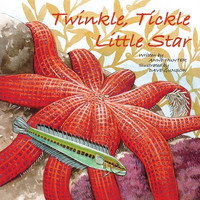
Taking the Lead, by David Hill and Phoebe Morris (Penguin NZ)
David Hill and Phoebe Morris have proven themselves to be a wonderful team with their range of illustrated biographies of amazing New Zealanders from throughout our nation’s history. These biographies always begin at unexpected parts of the story. For Ed Hillary, it was reaching the top of the hill on a family farm. For Jacinda, it’s learning to drive in a tractor, to show ‘she’s already going places.’
The pace of the story is good, though it is clear it’s been tricky for the author and editor to work out what bits of her life are important. I feel as though Jacinda selling golf balls back to the players on the nearby golf course was an odd choice of snippet, though perhaps Hill was aiming to show economic nous.
Jacinda selling golf balls back to the players on the nearby golf course was an odd choice of snippet, though perhaps Hill was aiming to show economic nous.
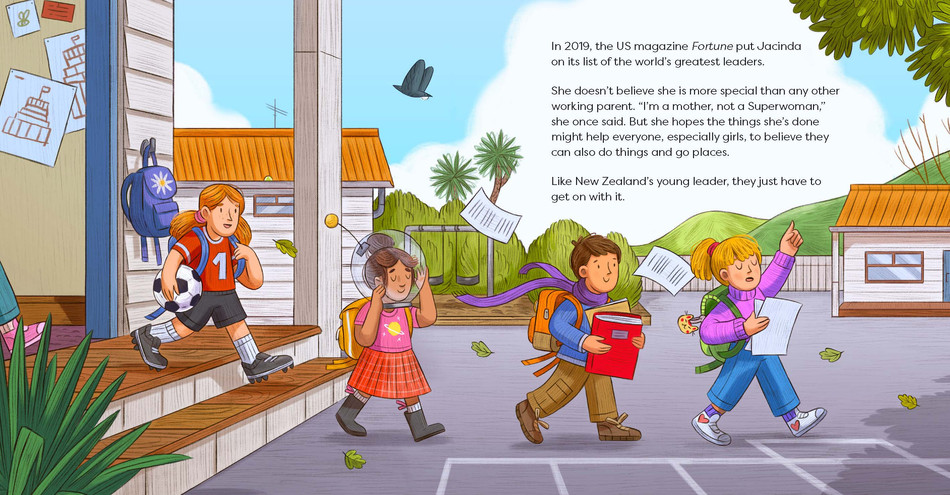
Phoebe Morris’ front cover image of Jacinda is wonderful, but my kids didn’t immediately match her illustration with the Jacinda they’ve seen on the screen. Throughout the snippet scenes of her life, Morris uses simple cartoon facial expressions to paint the picture of a fairly quiet early life. These are great in small images, but I wished that when an illustration is given a full page, Morris would put more details in and show a more detailed portrait of Jacinda. That being said, there are some wonderful illustrations throughout, and I particularly like her use of space in the full spreads, like that shown above.
Even reading these bare details of Jacinda’s life, no child could remain unimpressed with her dedication to helping others. From her early days coordinating campaigns, through her time doing research for Helen Clark, and her volunteering, joining the International Union of Socialist Youth, and working for human rights across the world.
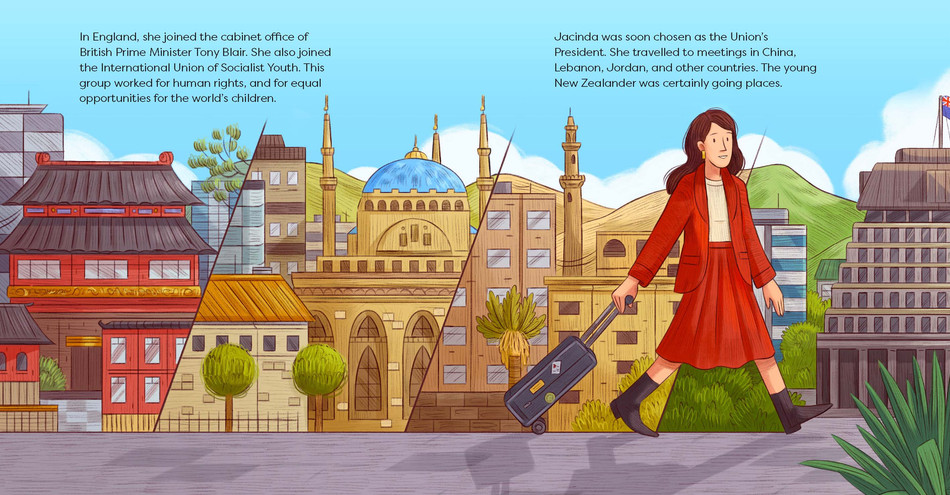
Even reading these bare details of Jacinda’s life, no child could remain unimpressed with her dedication to helping others.
An undercurrent of all of these opportunities though, perhaps because they aren’t fully acknowledged, is the privilege afforded to people connected in the right ways. She became part of the Labour Party because of an aunty. And you don’t just walk into the cabinet office of a UK Prime Minister without a recommendation from (everyone’s) Aunty Helen. There are kids, and parents, that will notice this easy movement within the world of Pākehā privilege.
An undercurrent of all of these opportunities though, perhaps because they aren’t fully acknowledged, is the privilege afforded to people connected in the right ways.
It seems remarkable, in the time of Chlöe Swarbrick, that Jacinda was at the time she was elected, the country’s youngest MP. Twenty-eight is no longer young for a politician in this age of climate strikes and an increasing awareness of politics by our teenage generation.
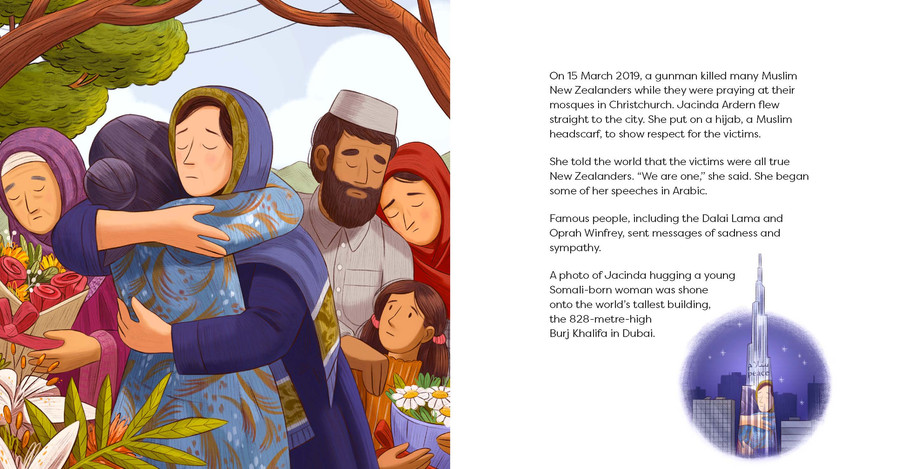
A refrain Hill uses throughout the book to describe Jacinda’s practical nature is ‘she just got on with it.’ This mantra has served her well in the current COVID-19 crisis. She has been unflappable, and incredible, as she was in her response to the Muslim terror attack.
I’d recommend this book as a good read for parents to read to young kids, and I think my slight qualms may be related to the fact that this is the first in this series about a living subject. It would be great to see this series expand to include influential Māori and Pasifika people from our history, who are missing in action in the series thus far.
